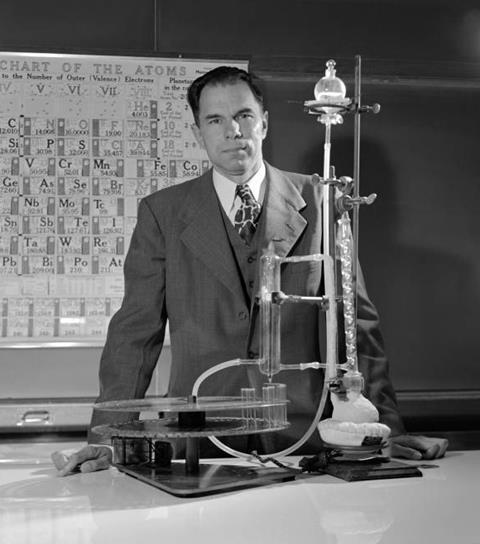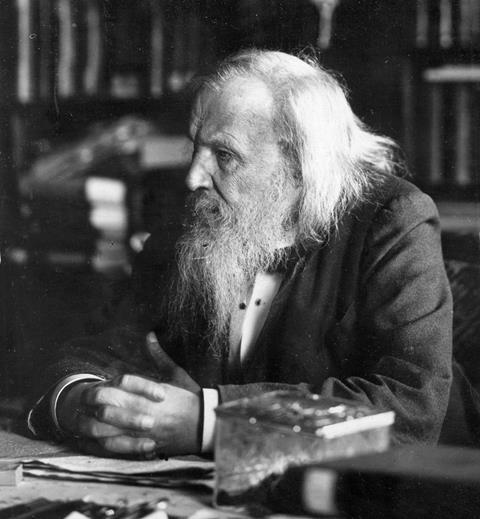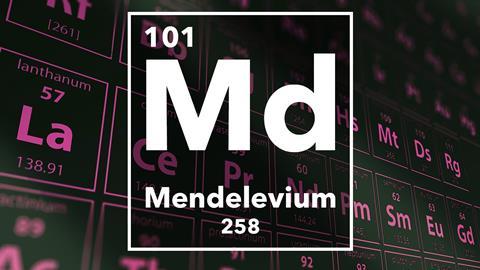Meera Senthilingam
This week's element pays tribute to the creator of the periodic table. Here's Hayley Birch:
Hayley Birch
In 1933, Albert Einstein was visiting a friend at the University of California, Los Angeles, when he was introduced to an aspiring scientist by the name of Glenn Theodore Seaborg. Seaborg was studying chemistry and was only an undergraduate, but Einstein took the time to talk to him and encourage him in his scientific endeavours.
This meeting seems to have had a profound effect on the young Seaborg, who went on, like Einstein, to become a Nobel Prize winner and wrote in a tribute many years later that he had been much impressed by the great man's modesty and kindness. He also remarked upon Einstein's dedication to peace and was perhaps inspired by him in his own attitude to war. Despite playing a central role in the creation of the atomic bomb by helping to separate plutonium from uranium, he is said to have remained a pacifist and believed that nuclear energy should be used only for good.

By what appears to have been pure coincidence, it was on the day of Einstein's death – the 18 April 1955 – that the American Physical Society received a paper from Seaborg and his colleagues at the University of California, Berkeley, announcing the discovery of a new radioactive element that was to become known as mendelevium. At its most stable atomic weight of 258, it is considered one of the 'superheavy' weights of the periodic table. Like most of the heavier elements, it's so large that it has trouble sticking itself together and usually decays after just a couple of hours – which is why Seaborg and his colleagues had to create it synthetically.
Considering his contribution to the Manhattan project, mendelevium was certainly not Seaborg's most significant achievement. It was not even his first element: he was part of a team based at the Radiation Laboratory that had already announced the discovery of americium and curium, as well as berkelium and californium, named after his own university. Four years previously he had been awarded the Nobel Prize, along with Edwin McMillan, for these very achievements, lumped together under what they called the trans-uranium elements – because they had atomic numbers higher than uranium.

At atomic number 101, mendelevium was a different type of element: the first of the trans-fermium elements. But to make it, Seaborg employed the same piece of equipment – the particle accelerator that had been used to chemically identify plutonium after it was discovered by Enrico Fermi during the Second World War. The '60-inch Cyclotron', as it was called, was built according to the design of Ernest Lawrence, another of Seaborg's colleagues from the Manhattan project, and had already been in operation for well over a decade. When it was finally decommissioned in 1962, it was hailed as the 'most productive atom-smasher in history'.
To make their synthetic element, Seaborg's team began with a tiny amount of another element, one which had first shown up in the fallout of a nuclear test carried out by the US in 1952. This other element was later to become einsteinium but it appears in the mendelevium paper as simply '99', accompanied by its isotope number, 253. The team used the cyclotron to smash helium ions into their 'element 99' and produce just a few atoms – 17, to be precise – of mendelevium. Even since its discovery, so little mendelevium has ever been produced that scientists haven't had a chance to find a use for it.
In the Physical Review paper announcing their discovery, Seaborg and his colleagues paid tribute to yet another great scientist. As they wrote: "We would like to suggest the name mendelevium...in recognition of the pioneering role of the great Russian chemist, Dmitri Mendeleev, who was the first to use the periodic system of the elements to predict the chemical properties of undiscovered elements."

And perhaps there is no more fitting time in this series to pay our own tribute to Mendeleev, who is, after all, the man responsible for the Periodic Table on which the Chemistry in its Element podcast is based. Brought up in Russia, Mendeleev was the sort of person who, it seems, was incapable of sticking to one discipline and as well as serving as the director of the Russian institute for weights and measures, had a hand in developing the Russian oil industry. Given all this, it's perhaps less surprising than it ought to be that he conceived of the Periodic Table on the same day that he was supposed to be inspecting a cheese factory.
And so, in mendelevium, Mendeleev got his element and, eventually, so did Seaborg, whom element 106 is named for.
Meera Senthilingham
So, both Mendeleev and Seaborg got their elements in the end. That was science writer Hayley Birch, bringing us the atom-smashing chemistry of mendelevium.
Now, next week, continuing along the lines of smashing atoms, we go one step further and experience elemental warfare.
Simon Cotton
In the days of the Cold War, America and Russia rivalled each other in all sorts of ways. Never mind thermonuclear bombs and intercontinental ballistic missiles to deliver them, they competed in putting men and women into space; who could win the most medals in the Olympic Games; and in making new chemical elements. In the case of element 105, the controversy went on for nearly 30 years and was part of the so-called 'Transfermium Wars', when no blood was spilt but a great deal of ink was.
In the red corner, the Soviet team at the Joint Institute for Nuclear Research at Dubna, near Moscow, led by Georgy Flerov. In the Blue corner, the American team at the University of California at Berkeley, led by Albert Ghiorso.
Meera Senthilingham
And to find out which side came through with the chemistry (and name) of element 105, dubnium, join Simon Cotton for next week's chemistry in its element. Until then, I'm Meera Senthilingham and thank you for listening.













No comments yet